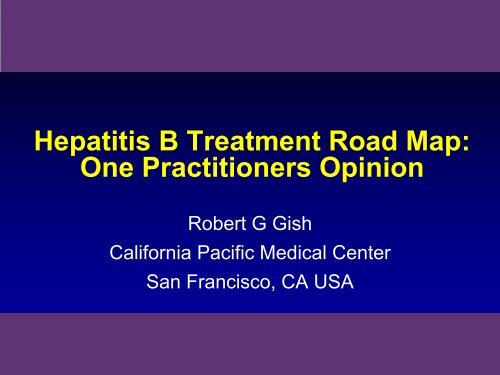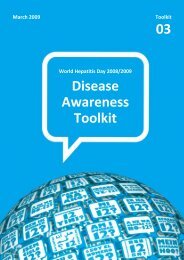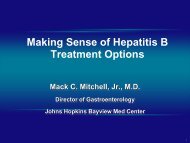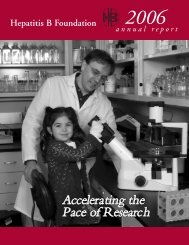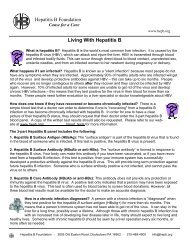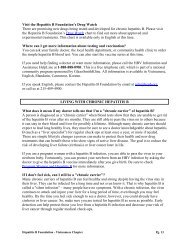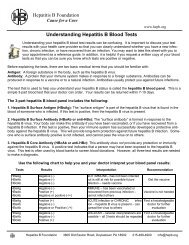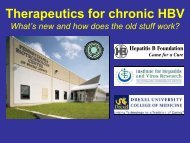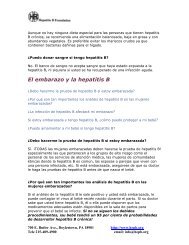Do We Need A Roadmap or GPS?, Dr. Robert Gish - Hepatitis B ...
Do We Need A Roadmap or GPS?, Dr. Robert Gish - Hepatitis B ...
Do We Need A Roadmap or GPS?, Dr. Robert Gish - Hepatitis B ...
- No tags were found...
You also want an ePaper? Increase the reach of your titles
YUMPU automatically turns print PDFs into web optimized ePapers that Google loves.
<strong>GPS</strong>, Road Map <strong>or</strong> Seeing Eye<strong>Do</strong>g?
The map you use dependsupon where your are! Andwhere you are going• The road and travel method to NewY<strong>or</strong>k• Approach also depends:–Budget–Willingness to take risks–How fast one wishes to get there
Basics• F<strong>or</strong> any person at risk f<strong>or</strong> HBV one must test :• HBsAg = infection• Anti-HBc = exposure• Anti-HBs = immunity• Liver panel
Second level testing• F<strong>or</strong> all patients who are HBsAg (+)– To determine prognosis: risk of cirrhosis, cancer, deathand transplant• HBV DNA quant– To determine wild type vs. pre c<strong>or</strong>e mutant• HBeAg• Anti HBe
All patients: consider• <strong>Do</strong>cumenting immunity to HAV <strong>or</strong> perf<strong>or</strong>mvaccination• Screening f<strong>or</strong> HCV• Testing f<strong>or</strong> delta virus• HCC screening
Liver tests• Liver enzymes– ALT– AST These liver enzymes are not liver function tests– GGT– Alk Phos• Liver Function:– Albumin– INR (coagulation test)– Bilirubin
Should the roadmap include“healthy” ALT in treatmentdecisions?•Patients should be treated if:–DNA positive, and–ALT elevated•Women >19•Men >25
Significant Histological Findingsin Patients with N<strong>or</strong>mal ALT• Study compared liver histology in CHBpts with persistently n<strong>or</strong>mal (n=139) andabn<strong>or</strong>mal (n=135) ALT• N<strong>or</strong>mal ALT group:– 24% significantfibrosis–9.4% cirrhosis• Within n<strong>or</strong>mal ALT range, fibrosis ratehigher in ptswith higher ALT• Age >40 years significant risk f<strong>or</strong>fibrosis• No c<strong>or</strong>relation with HBeAg status <strong>or</strong>HBV DNA level50403020100Risk of Fibrosis by ALT Level43.519.8Percent
Should our roadmapinterpret HBV DNA?•Is there any level of HBVDNA which is “safe” f<strong>or</strong>HBV patients?–No risk f<strong>or</strong> HCC <strong>or</strong> cirrhosis
Multivariate Cox RegressionAnalysis: REVEAL, part 2HBsAg / HBV DNA level, copies/mLduring follow-upAdjusted hazard ratiop value(time-dependent variable)
One Idea f<strong>or</strong> a<strong>Roadmap</strong>•DNA +Treat
The <strong>Roadmap</strong> must also includefinancial considerations
$$Financial GradientDNA >2,000 IULam first f<strong>or</strong> allThen addADFOrTDFIf ALT incFew medication resourcesLimited lab testingLimited NATDNA >2,000 IU“<strong>Roadmap</strong>”3m Lam6m LdT12m ADF3 yr ETVAddSecond agentNRAt low DNAPre-ALT flareLimited medication resourcesNAT lab testingAll DNA +RxETV<strong>or</strong>TDFR ptscomboAll DNA +RxETVAndTDFInfinite MedicationAnd lab<strong>or</strong>at<strong>or</strong>y resourcesRobust medication resourcesExtensive NAT lab testing
Real W<strong>or</strong>ld: Insurance and costrestraints, part 1• Use the most powerful <strong>or</strong>al single medication with thelowest rate of resistance– Monotherapy with ETV appropriate f<strong>or</strong> >90% oftreatment naïve• Expect comparable TDF data: approval in US pending– Lamivudine as primary Rx?• up to 80% of patients will need combination therapy• ADF + LAM = ETV costs in most countries– Adefovir: 40-60% will need add-on therapy due to risk(<strong>or</strong> presence) of resistance <strong>or</strong> lack of 1 year primaryresponse
Real W<strong>or</strong>ld: Insurance and costrestraints, part 2• ETV: 5 years of data: profound suppression, 1%resistance at 5 years• TDF: 1.5 year of data: Profound suppression,0% resistance at 1 year• ETV + TDF in US is $13,000/year– Much less expensive in other parts of thew<strong>or</strong>ld
If you are going to use lamivudine, useonly in special settings• Naive: Patient– Low level of virus– Financial restrictions– Active monit<strong>or</strong>ing and management• No alternative therapies• Pregnancy• Combination therapy• Hist<strong>or</strong>ical and ongoing use and on treatment HBVDNA negative on multiple tests
HBeAg seroconversion is considered apo<strong>or</strong> therapeutic end pointTreatment-inducedseroconversionn = 116Spontaneousseroconversionn = 182P valueRemission of ALT (months) 14.13 22.44 0.0370Remission of ALT Less robust M<strong>or</strong>e robust -HBeAg(-) reactivation rateat 96 months* 44% 25% 0.0460HBeAg reversion at 48 months* 24.09% 11.29% < 0.0094* Adjusted f<strong>or</strong> age, gender and ALT with Cox regressionLim SG, et al. Hepatol Int 2008;2:A217–A218(Abstract PE1049), and poster presentation at APASL 2008.20
Pre-existing c<strong>or</strong>e promoter and pre-c<strong>or</strong>emutants in HBV patients• In patients with HBeAg(+) disease, the presence of c<strong>or</strong>e promoter andpre-c<strong>or</strong>e mutants is common27-42% of patients with HBeAg + disease have the mutant HBV virusAll patientsHBeAg(+)HBeAg(-)80% 80C<strong>or</strong>e promoter variant%707060605050404030302010 201000 A B C D AlltypesChu CJ, et al. Gastroenterology 2003;125:444–451.Pre-c<strong>or</strong>e variantA B C DAlltypes21
Should the new <strong>Roadmap</strong>include pretreatment prec<strong>or</strong>eand c<strong>or</strong>e promoter mutationtesting in all patients who areHBV DNA positive?My recommendation is “yes”22
As we travel the road toHBV viral negativity, arewe changing outcomes?
Changes in Size of Esophageal Variceswith LAMIVUDINEADEDOVIR• EV w<strong>or</strong>sened in 3% with longtermHBV suppression withLAM ADV vs.. 25% withLAM+ADV after clinicalresistance (p=0.0003)• Overall, yearly rates of developmentand progression of EV were 2.0 and2.0, respectively, both lower thanexpected in coh<strong>or</strong>t of untreated virologiccirrhosis*HBV-DNA persistently < 3.3 log10 copies/ml on therapy with LAM <strong>or</strong> LAM+ADV f<strong>or</strong> virological resistance**HBV DNA10 > 6 log and ALT > ULN, confirmed by molecular analysis.Iavarone M, et al. 58th AASLD; Boston, MA; November 2-6, 2007. Poster 775.1009080706050403020100RegressionStableProgression (p=0.0003)Response*N=81Resistance**N=42
US UNOS: Liver TransplantWaitlist Registrants with HBV500450400350300250200150100500ESLDHCCAcute4321985 1990 1995 2000 200552271128
How does the adefovirtreatment vehicle fit ourtravel plans ?
Can we change ourconvoluted travel route?•Can we change from the “flight ofthe bumble bee” to the “directroute?”•Is there a “4 wheel drive allterrainvehicle” f<strong>or</strong> HBVtreatment?
ADV+LAM vs.. ADV f<strong>or</strong> HBeAg- LAM-R Patients3-yr Cumulative Probability ofVirological Response (< 3 Log) by Baseline Viremia10099%806078%71%4020p
ETV Efficacy vs.. Baseline HBV DNALevelsMedian HBV DNA Levels of nucleoside naïve, HBeAg positive andnegative patients treated with ETVBaseline HBV DNA (copies/mL)Baseline≥10 1110 10n=87n=4010 9n=14910 8n=14210 7n=97n=8010 6n=2710 5n=1310 410 310 2024 36 48 72Treatment <strong>We</strong>ekColonno RJ, 41 st EASL 2006, Vienna, # 490• ETV efficacy independent ofbaseline HBV DNA levels• 348/369 (94%) patients withbaseline HBV DNA levels
Results:Projected Ten-Year Risk: Use MarkovModelingHCC Cirrhosis Any Liver EventETV 2.9% 8% 8.8%ADV 7.5% 15.7% 17.8%Iloeje et al, EASL 2006, Abstract #497
Will TDF be added to the<strong>Roadmap</strong>?• Yes, likely to replace ADF in thoseareas of the w<strong>or</strong>ld where it is available
TenofovirHBeAg+ patients: % HBV DNA
Study 102, HBeAg- Patients: 72-<strong>We</strong>ekTDF vs. 48-<strong>We</strong>ek ADV → 24-<strong>We</strong>ek TDFP < .001 P = .315HBV DNA
The Resistance Route if full of canyonsand peaks
Genotype-Independent Numbering Scheme f<strong>or</strong> HBV Polymerase/RTTerminalProtein1 183 349(rt1)<strong>Do</strong>mainSpacer POL/RT RNaseH692 (rt 344)845 a.a.I(G)II(F)F__V__LLAQ__ YMDDA B C D ErtL80V/I rtV173L rtM204V/I/SLMVrtL180MADV rtA181T rtN236TETV Resistance rtI169T rtL180M rtT184S/A/I/L/G/C/MrtS202C/G/I rtM204V rtM250I/VTDF Resistance rtL180M rtA181T/V rtA194T/rtM204V/I rtN236TL-dT Resistance rtA181T/V rtM204IClevudine rtL180M rtM204VThe location of the maj<strong>or</strong> antiviral drug-resistant mutations associated with lamivudine (LMV), adefovir (ADV), and entecavir (ETV), telbivudine(LdT) tenofovir (TDF) resistance. Modified from Locarnini S. 2004. Sem in Liver Dis 24 (Suppl 1):3-10.
Resistance is badResistance is common• Lamivudine: up to 100% by year 5• Adefovir: 29-42% by year 5• Telbivudine: 10-20% by year 2• Entecavir: treatment naïve: 1% year 5– Nucleoside resistance: 50% by year 5• Tenofovir: 0% by year 1.5• Interferon: no resistance
What is the roadmap f<strong>or</strong> resistance?• Complex• Based on:–Viral fact<strong>or</strong>s–Patient fact<strong>or</strong>s–medication availability
Management of HBV ResistanceLamivudine/TelbivudineResistanceAdefovir ResistanceEntecavirResistance*Adefovir/TenofovirLamivudine/Telbivudine• Add-on preferred because • Add preferred overof better viral suppression switch [5,6]and lower incidence of ADV Entecavirmutations [1-3]• Add preferredEntecavir Switch and • Or• Add TDF because of lower • Switch to entecavir (if nocross-resistance issues [4] pri<strong>or</strong> lamivudine• OK to add ADFresistance) [7]Potential future approach Potential future approach• Switch to• Switch to clevudine/*With preexisting lamivudine resistance.emtricitabine/tenofovir? tenofovirAdd tenofovirAdd adefovir [8]1. Peters M, et al. Gastroenterology. 2004; 126:91-101. 2. Perrillo R, et al. Gastroenterology. 2004;126:81-90. 3. Fung S, et al. J Hepatol.2006;44:283-290. 4. Chang T, et al. Gastroenterology. 2005;129:1198-1209. 5. Villeneuve J, et al. Hepatol. 2003;31:207–210. 6. Fung S, et al. JHepatol. 2005;43:937-943. 7. Fung et al. J Hepatol. 2005;43:937-943. 8. Villet S, et al. AASLD 2005. 981.
What is the new paradigm?What is the best road map?• Treat all patients until HBsAg negative• Will need cost modeling!• Incremental cost-effectiveness ratios (ICER) perquality-adjusted life-year (QALY) key toidentifying the best road ahead
What does the roadmap say is the bestroute through “interferon” country?• Focused role– High ALT– Low to moderate HBV DNA• When patient asks f<strong>or</strong> defined treatment period– A woman wishing to get pregnant in 1-2 years• Where government pays only f<strong>or</strong> one year of therapy– Choose patient with• Higher ALT• Lower DNA• HBeAg negative patients– Use as first line therapy !• Especially If there is an assay f<strong>or</strong> HBsAg: Architect Assay
Marcellin et al EASL 2008: PEG alfa 2aSummary of response rates4 years post-treatment30252724PEG-IFNα-2a +/– LAM (N=230)LAM (N=85)Patients (%)2015101816P=0.0421766%11% HBsAg lossP=0.021117520ALT n<strong>or</strong>mal*
Who is best patient f<strong>or</strong> interferon?• High ALT• Low HBV DNA• Liver function: n<strong>or</strong>mal
It is no longer darkoutside and you havea simple map
<strong>Roadmap</strong> to manage <strong>or</strong> prevent resistance inTreatment-Naive PatientsAvailable treatmentoptionsLAM/ADV TDF ETV TelbivudineResponse andResistanceMonit<strong>or</strong>ingMeasure HBV DNA with sensitive assays;monit<strong>or</strong> virologic changes every 3-6 months;monit<strong>or</strong> f<strong>or</strong> breakthrough, and compliance etcOutcomeNo resistanceidentifiedwith viralnegativityResistanceidentified“Suboptimalresponse”:4-12w Lam6m: LdT1 year ADF3+years ETV/?TDFTherapeuticPlanContinue withplannedmedicationAdd secondmedicationadd secondmedication
The Future?• TDF: What will its clinical resistance profile be?• Clevudine:– Will it induce a long term, off- treatment, viralresponse? <strong>or</strong>– Will it have clinically imp<strong>or</strong>tant cross-resistance withother nucleosides ?• Will m<strong>or</strong>e sensitive assays be available todetermine changes in treatment when early viralresistance emerges?– Ultra deep pyrosequencing
Ultra-Deep Pyrosequencing f<strong>or</strong>HIVWang, Mitsuya, et al. Submitted
Design of Nucleonics’ Multi-TargetingAnti-HBV eiRNA NUC 500-001AKan rOptimizedPol III promoterBRNAi Target Sites on HBV mRNAsABCDDPre-genomic / pre CPre-S1Pre-S2/SXOriCAll HBV RNAs are targeted f<strong>or</strong> degradation
What is the best road map tomanage HBV?•HBV DNA positive = Treat•Use the therapy with thehighest response rate and thelowest rate of resistance•Pursue HBsAg seroconversion
Thank you• HBV Foundation• Tim and Joan Block• Fiona Ma• CPMC HBV Team• gishr@sutterhealth.<strong>or</strong>g


